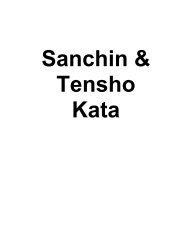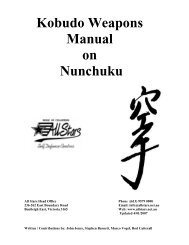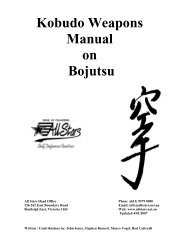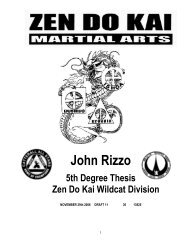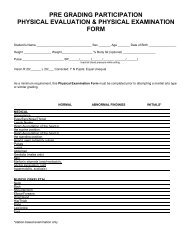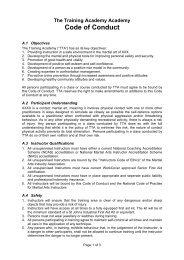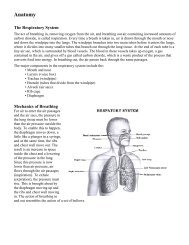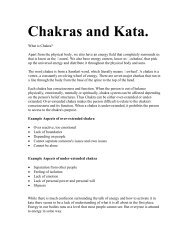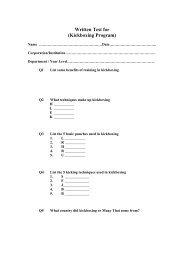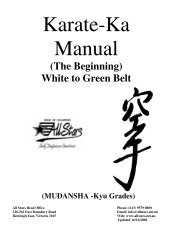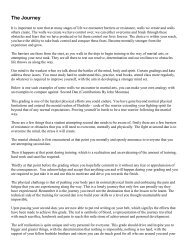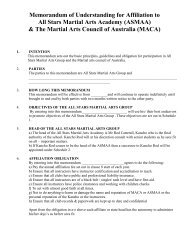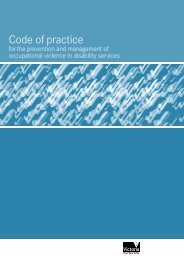Origins & History of Goju Weapons Kata - All Stars Self Defence ...
Origins & History of Goju Weapons Kata - All Stars Self Defence ...
Origins & History of Goju Weapons Kata - All Stars Self Defence ...
You also want an ePaper? Increase the reach of your titles
YUMPU automatically turns print PDFs into web optimized ePapers that Google loves.
<strong>Origins</strong> & <strong>History</strong> <strong>of</strong> <strong>Goju</strong> <strong>Weapons</strong> <strong>Kata</strong>Okinawan Kobudo <strong>History</strong> - A traditional weapon art.The word "kobudo" means "ancient weapons way". Okinawan kobudo had its start around 400 years ago when Japanbegan to assert control over the Island <strong>of</strong> Okinawa. Warlords forced the Okinawan people to turn over their weapons tothe Japanese. The move was made by Imperial Japanese leaders with almost no realistic political foresight and verylittle insight or perception into the Okinawan way <strong>of</strong> thinking. The ruling classes assumed that to gain political andfinancial control over this tenacious island race, all that was necessary was to disarm the people. The warlordsspecifically ordered that "all weapons" be turned over to the authorities. Little did the authorities realize that theOkinawan people were such a nationalistic race and so strongly devoted to freedom that they would go to any lengths todeceive and/or hide the weapons they needed to fight their oppressors. The resourceful Okinawans adapted everydayfarming and fishing implements -- 6-foot staff (bo), rice-grinder handle (tonfa), horse's bridle (nunchiyaku), boat paddle(ueku), rice sickle (kama), etc. -- for self-defensive purposes. Thus, weapons were called "farm implements", butunderground the fighting population was training in the use and pr<strong>of</strong>iciency <strong>of</strong> these tools.Soon the weapons masters became a most feared force in the battle for political freedom, feared by the Japanese andidolized by the Okinawan people whose protectorate they were. This was the birth <strong>of</strong> what we now know as OkinawanKobudo. Over time, the use <strong>of</strong> these weapons became formalized into a beautiful, graceful, and effective art that hasbeen passed down from generation to generation.At different times and for various reasons during its history, weapons were banned on the island <strong>of</strong> Okinawa. In 1429,Sho Hassi united the kingdom <strong>of</strong> Okinawa under his rule and renamed North and South. During the era <strong>of</strong> his grandsonSho Shin, the policy <strong>of</strong> "Bunji-Kokka", or government by culture not military force, was put into effect. At this time allweapons were banned except for those used by military forces in 1477. The objective was to restore peace and todisarm rival clans.Upon seizing control <strong>of</strong> Okinawa in 1609, the Shimazu clan instituted numerous rules <strong>of</strong> martial law, one <strong>of</strong> which was aban on all weapons. This time, however, the ban was on a much larger scale than that instituted by Sho-Shin. Only theSatsuma samurai, who were the invaders and conquerors <strong>of</strong> Okinawa, were allowed to have weapons.The methods used by the Satsuma for enforcing the weapons ban were ruthless. Any weapons found in an Okinawan'spossession were immediately confiscated and the owner was severely punished. As part <strong>of</strong> the ban, the Shimazu alsoprohibited the Okinawans from participating in the study or practice <strong>of</strong> the martial arts.This ban had a number <strong>of</strong> serious effects on the Okinawan martial arts. <strong>All</strong> study and participation was forcedunderground, and all teaching was done by word <strong>of</strong> mouth only. No written records exist which would allow us to tracethe development <strong>of</strong> the Okinawan arts during this time period. This has led to the creation <strong>of</strong> many false legends due tothe inability to document facts.Secrecy became such an obsession that instructors hid true techniques from rival schools, as in the changing or hiding<strong>of</strong> moves in kata. This eventually led to the development <strong>of</strong> new and unique fighting techniques and systems includingthe modification <strong>of</strong> farming and work tools into weapons for combat use. The fighting attitudes in the martial artsschools became very violent due to the suppression <strong>of</strong> civil liberties and the general sentiment <strong>of</strong> the times.And above all, the ban made Karate one <strong>of</strong> the most practical and effective hand-to-hand combat systems everdeveloped. The need for practical application kept Karate from degenerating to a mostly theoretical art or a simple orobscure form <strong>of</strong> exercise.Aragaki Seisho - Aragaki the Cat (1840-1920) a Nahe te Master was also said to <strong>of</strong> been pr<strong>of</strong>icient at Ryukyu Kobudo,and was responsible for passing on the following Kobudo <strong>Kata</strong>: Urasoe Bo, Sesoko no Sai, Shokyu no Kon, Aragaki noSai and Tsuken Hantagwa no Sai.The weapons <strong>of</strong> traditional Okinawan Kobudo can be divided into two groups or categories: the Major <strong>Weapons</strong> and theMinor <strong>Weapons</strong>. The major weapons are those which are widely known and practiced with numerous traditional kata inexistence. The minor weapons are those lesser-known weapons for which a limited number <strong>of</strong> kata exist. In fact, withsome <strong>of</strong> the weapons, practice is limited to weapons manipulations and one-step applications. The major weapons <strong>of</strong>Okinawan Kobudo include Bo, Numchuku, Sai, Kama, Tonfa.Below is a list <strong>of</strong> only some <strong>of</strong> the weapons that exist in the Okinawan weapons range. Many Okinawan Karate stylesinclude these five major weapons in their training to some degree. Training with these five weapons helps to developsimilar muscles as used in karate as well as hand-eye coordination and heightened reflexes. Many <strong>of</strong> the striking andblocking techniques practiced in everyday Karate can be easily adapted to use when armed with these weapons, makingthe transition to training with these weapons relatively easy and most beneficial to the karateka
Below are a list <strong>of</strong> Okinawan weapons.Okinawan Name English Name Composition <strong>Kata</strong> <strong>Origins</strong>1. Kon or RokkushakuBo (Compulsory)(Staff) , its variant JowoodenOur system is mostly <strong>of</strong> Yamaneryuheritage. There are about twenty knownkata for this weapon including Shuji No KonSho, Shuji No Kon Dai, Koshiki No Shuji,Shu shi no Kon, Sakugawa No Kon Sho,Sakugawa No Kon Dai, Sakugawa No KonChu, Soeshi No Kon Sho, Soeshi No KonDai, Sueyoshi No Kon, Kong No Kon(Taira Shinken's Bo <strong>Kata</strong>):Shirotaru No Kon Sho, Shirotaru No KonDai, Sesoko No Kon, Yonekawa No Kon,Tsukenbo, Chinenchichanaka,Chatanyara, Choun, Urasoe,Tsukensunakake, Tokubetsu-Bo: Kyu ShakuBo, San Shaku Bo, Matsu Higa no kon, TenU no kon, Chatan Yara no kon,(Matayoshi Kobudo Bo <strong>Kata</strong>):Shushi Nu Kun, Choun Nu Kun, SakugawaNu Kun, Chikin (Tsuken) Nu Kun, Shiishi NuKun, Ufutun no Kun, Chatan Yara no Kun,Kubo no Kun, Yonegawa no Kun(Isshinryu Bo kata ):Tokomine No Kon,Urashi No kon,Shishi NoKon No Dai2. Nunchaku2 wooden sectionsconnected with cordThere are about six katas for this weapon.Nunchaku no Sho, Nunchaku no Dai, SanBon Nunchaku(Matayoshi Kobudo Nunchakukata):Kohbu Nunchaku kata Ichi,Nunchaku<strong>Kata</strong> sandan3. Sai(Iron Trident, Truncheon) its variant Jitte3 pronged metalweapon<strong>Kata</strong>, including Tsukenshitahaku no Sai,Hamahiga no Sai, Yaka no Sai, Hantaguwa,Kojo, Tawata, Chatanyara no Sai, Manji noSai, Jigen no Sai, Aragaki no sai, Sokon nosai,(Matayoshi Kobudo Sai <strong>Kata</strong>):Nicho Sai(also called as Ni Cho Zai, SanchoSai(also called as San Cho Zai) andShinbaro No Sai (also called as Matayoshino Sai)(Isshinryu Sai kata) :Kusanku no Sai,Chatanyara no SaiAbout 12 kata exist for this weapon.4. Tonfa or Tunfa orTsuifa(Wooden Truncheon )wooden handle fromgrinding stone againred oak or white oakCurrent kata include Hamahiga no Tonfa,Yaraguwa, Matsu Higa no tonfa(Matayoshi kobudo Tonkua kata) :Tonkua <strong>Kata</strong> Dai Ichi,Tonkua <strong>Kata</strong> Dai NiThere are about 8 kata associated with thisweapon.5. Kama (Sickles) wood and iron6. Eku or Eiku (Oar) woodenThe kata called Tozan, Kanigawa no Sho,Kanigawa no Dai(Matayoshi Kobudo Kama <strong>Kata</strong>) :Kohbu Nicho Gama(also called as TairaguwaGushikawa No Kama No <strong>Kata</strong> Ichi)The kata named Tsuken Akachu No Eiku De(Also called as Chikin Akachu No Eiku De)
horses bridles etc. as being the origins <strong>of</strong> this weapon, these are merely coincidental. The weapons origins can clearlybe traced back to China and be found in Indonesia and surrounding geographical locations. While the weapon may havebeen introduced into Okinawa via China (or elsewhere in southern Asia), it still does not rule out its use as a mill handle.5. Kama (Sickle)Kama- jutsu is also called "Kama nu ti". About 700 years ago, in King Eiso's reign,agricultural tools such as hoes and sickles began to be made <strong>of</strong> iron. Along with thesefarm tools, many weapons were imported from mainland Japan and China in that era.Kama was first used as a weapon by farmers around 1314 A.D. when warriors andfarmers rose up against King Tamagusuku's oppression. As a result, three chieftainswere established. The kama was one <strong>of</strong> the most familiar pieces <strong>of</strong> farm equipment thatcould be used as a substitute weapon. The kama has not been used much for developingkata or for tanren. Most <strong>of</strong> the techniques have been developed from karate. Becausethe kama is a weapon with a blade and therefore incorporates a high degree <strong>of</strong> danger, itis somewhat different from the other forms <strong>of</strong> kobudo weaponry.In this jutsu, a pair <strong>of</strong> Kama are used separately or connected with a string. There was also a Kama attached to a150cm Bo. The effect <strong>of</strong> a Kama increases when used in a pair. In fighting, another Kama is hidden behind the back forthrowing. The angle <strong>of</strong> the Kama to its handle is 90 degrees, but it can be 30, 45, or 60 degrees when used in a pair,increasing its killing efficiency. It is said that even sword masters avoided fighting Kama masters. However, a kamamatch involving rokushaku-bo (180 centimeter-long sticks), can be very thrilling. The techniques include ukete sasu(blocking and stabbing), tsuku (thrusting) and kiru (cutting), as well as nagete ateru (throwing and striking). The katacalled Kanegawa no Nicho-gama remains today.6. Eku or Eiku Jutsu (Oar)The eku is one <strong>of</strong> the lesser-known Okinawan weapons. The Eku was, and is, a genuine tool <strong>of</strong> Okinawan fisherman. Itspopularity was obviously greatest in fishing areas, like Tomari and some <strong>of</strong> the outlying islands. The Okinawan oar isonly slightly shorter in length than a Bo, and has a long narrow paddle. One side <strong>of</strong> the paddle is flat, or gently convex,while the other side is peaked. The tip is rounded or slightly pointed.It can be used in a manner very similar to the bo, thrusting and striking one's opponent. because <strong>of</strong> its heavier massand bladed edges, it has formidible sriking power when used in cutting motions. It has one other unique property - itcan be used to scoop sand at the opponent's eyes! The kata named Tsuken Aka Chu No Eku De remains today. The oarhas not been very popular in Japan, however, it is not uncommon among high level Karate-ka on Okinawa.7. Rochen or Tenbi Jutsu (Short spear/ machete & Shield)This weapon is the most glamorous <strong>of</strong> the Ryukyu system and exudes a feeling <strong>of</strong> history long gone. The usage howeveris more akin to a combination <strong>of</strong> Zulu fighting and European sword and small shield fighting. The Tembe (Shield) can bemade <strong>of</strong> various material but is commonly found in vine or cane, metal, or for presentation, in turtle shell. The shieldsize is generally about 45 cm long and 38 cm wide. The Rochin (Short spear) is cut with the length <strong>of</strong> the shaft beingthe same distance as the forearm to the elbow if it is being held in the hand. The spearhead then protrudes from theshaft and can be found in many differing designs. In this school <strong>of</strong> thought, the Tinbe is used more to hide the Rochenthan to defend against another blade..The favored style has an expanded middle section before the point, which is twisted upon insertion to make the woundlarger. The weight <strong>of</strong> the blade is critical for the spear usage, which is swiveled between the fingers to use both ends,smashing with the butt end and stabbing with the blade end. The techniques are circular to avoid too much directcontact on the shield and the short spear is predominantly used in an upward stabbing motion, piercing armor under therib cage, armpits, and throat. The techniques <strong>of</strong> the Tembe-Rochin are unique to shield and spear usage.8. Bokken / Ken Jutsu <strong>Kata</strong>Evidence suggests that swords have existed in Japan forits entire historical period. Short straight swords importedfrom China and Korea are among the earliest weaponsfound in sites around Japan. After 2000 B.C., when theseswords first appeared, the Japanese began making their own. Around 700 A.D., Japanese swordsmiths forged the first<strong>of</strong> what are now considered the finest swords ever made. The <strong>Kata</strong> below was developed by Kyoshi Raff Lanciana &Kyoshi Maurice Garnier <strong>of</strong> Zen Do Kai Wildcats.
9. Nitanbo <strong>Kata</strong> (Eskrima, Arnis or Kali)Due to the Spanish influence the Filipino Martial Arts came to be known as"Arnis de Mano" - derived from a Spanish word "arnes", meaning trappings ordefensive armor. It also acquired namesakes such as "estokada", "estoque","fraile", or simply "arnis". The word "eskrima" is derived from the Spanish word"esgrima", which means "a game between two combatants with the use <strong>of</strong>blunt instruments". The name <strong>of</strong> the stick which could be either rattan or apiece <strong>of</strong> hardwood used in "eskrima" is called either - "olisi", "baston" or"garote".A most practical technique is the use <strong>of</strong> Nitanbo, or two short sticks. It is a method similar to the well known PhilippineEscrima, or Arnis, and may even have come to Okinawa via the Philippines. Nitanbo are not considered commonweapons in China, but they can be found in Southern White Crane systems, such as "Two Short Rods". In Nitanbo, anapproximately 18 inch stave is held in each hand, with which to effect devastating combinations <strong>of</strong> circular, snappingand linear strikes.



